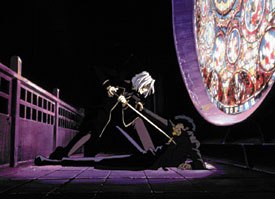Fans of the television series have been waiting diligently for Cowboy Bebop: The Movie, which opens in limited release, Friday, April 4, 2003. Fred Patten takes us through the history of this successful franchise and tells us what is in store on the big screen.

Cowboy Bebop: The Movie is finally here. The bounty hunters (clockwise from top) Jet Black, Faye Valentine, Edward Wong and Spike Spiegel track terrorists. Courtesy of Destination Films and Samuel Goldwyn Films, unless otherwise noted.
Anime fans do not need to be told how good Cowboy Bebop: The Movie is; they have been waiting impatiently for almost two years. In fact, fans have been suffering for the past year squinting at blurry bootleg video copies, or wincing at the pidgin-English subtitles on the imported Hong Kong DVD release. Now it is finally coming to American theaters with a superb English dubbing, co-distributed by Destination Films and Samuel Goldwyn Films. The initial release, on April 4th, will be in seventeen major cities across the U.S. If the box office is favorable, this may be expanded.
Hot, Hot, Hot
Cowboy Bebop has been a controversial favorite since it was created by Japan's Sunrise animation studio as an adult TV series five years ago. TV theme popularity tends to come in waves, and late 1997-early 1998 in Japan looked like the time for "space adventure" shows. Two of the better examples that season were Sunrise's Outlaw Star (an interstellar Treasure Island) and Madhouse's Trigun (a space Western on the planet Gunsmoke).

Director Shinichiro Watanabe crafted the Cowboy Bebop series as an homage to American movies and television. © Bandai Entertainment.
Cowboy Bebop was not just an average TV anime series for Sunrise. It was one that the entire studio got really enthusiastic over and assigned its top talent to. (Cowboy Bebop's creator-of-record is "Hajime Yatate," Sunrise's well-known house pseudonym for a team effort.) The leader of the creative team was director Shinichiro Watanabe, a fan favorite as the director of the futuristic military adventure series Macross Plus and Mobile Suit Gundam 0083: Stardust Memory. Watanabe wanted to design not just a space adventure series for adolescent boys but a program that would appeal to sophisticated adults. His main inspiration was the Lupin III anime series, which had been mega-popular from the late 1970s through the mid-'80s, about a debonair roguish international jewel thief and his "cool" gang in jet-set locales. They were sympathetic because they preyed upon truly despicable rich villains rather than the innocent.
Other leading members of Sunrise's creative team were scriptwriter Keiko Nobumoto, character designer Toshihiro Kawamoto, mechanical art designer Kimitoshi Yamane, and composer Yoko Kanno. Most of them had worked together before, in addition to having credits on other popular anime titles. Nobumoto had scripted Macross Plus, Kawamoto had designed the characters for Gundam 0083, and Kanno had written the music for Macross Plus (which needed an extremely strong score to support the plot about the rise of a popular singing idol who turns out to be a computer-generated Artificial Intelligence) and The Vision of Escaflowne. Yamane had not worked with Watanabe, but his credits included such other anime hits as Bubblegum Crisis and The Vision of Escaflowne.
The space-adventure update of Lupin III that Watanabe's team came up with was a "frontier" interplanetary culture of 2071 A.D. The Solar System has been colonized (forget the American publicity ad copy about humanity spreading "to the stars;" the action is all between Venus and Neptune), but it is a grungy society of mostly bubble-domed small communities on asteroids and the moons of the gas-giant planets, plus artificial space stations. Only Venus and Mars have any large cities. The cultural influences of this space society are as much Chinese as Western. There is a confusing conglomeration of independent governments, alliances and spheres of influence. The only system-wide organizations seem to be a unified police force, the ISSP (Inter Solar System Police), which is widely considered to be corrupt and ineffective; and powerful crime families which combine the worst aspects of the Italian Mafia and the Chinese Triads.

The Spaceship Bebop carries the team on their missions.
Due to the general helplessness of individual police forces at dealing with anything more serious than local petty crime, most governments have fallen back on posting rewards for the capture of serious criminals. This has created a new occupation of bounty hunters, popularly called "cowboys," who roam the Solar System looking for criminals with big rewards. Cowboy Bebop is about one particular "odd couple" team of these cowboys aboard the Bebop, a decrepit used spaceship. The core duo, introduced in the first episode, are Spike Spiegel and Jet Black, two macho good buddies who (it turns out from their conversation) only met shortly before deciding to team up and do not really know much about each other's pasts. The next few episodes add the remaining three of the team: Faye Valentine, a femme fatale bounty hunter, who alternates between joining their hunts as a partner and competing with them as a rival; "Ed," a young adolescent brilliant computer hacker (technically a she, although Ed is so androgynous that it is easier to think of her as an "it"); and Ein, an apparently normal dog (Welsh Corgi) with cryptic hints of abnormal capabilities. (One of the running gags of the series is leading the audience into trying to catch Ein doing something super-canine.)

Spike Spiegel, one of the first characters introduced in the TV series, also stars in the feature film.
Bebop History
The most important of the many elements that made Cowboy Bebop so successful is its sophisticated and mature attitude. Watanabe made no secret that, in addition to Lupin III, it was largely his tribute to his favorite American movies and TV series, which were shown in Japan during the 1970s and '80s including Butch Cassidy and the Sundance Kid (the relationship between Spike and Jet), anything with Bruce Lee (Spike is a martial-arts fanatic), anything with a blues or jazz sound track, and lots of Blaxploitation movies (the series has a very racially diverse supporting cast). Individual movies from Alien to Midnight Run were pastiched and parodied. One main attraction was that the audience was always kept guessing over the nature of the next episode. Would it be a comedy, a detective caper, an action thriller, a somber mood piece, which would reveal some more of one of the main cast's past, or something else unexpected. The hot music motif was emphasized in many of the episode titles (in English) such as: "Asteroid Blues," "Honky Tonk Women," "Ballad of Fallen Angels," "Heavy Metal Queen," "Jamming With Edward," "Jupiter Jazz" and "Mushroom Samba."







